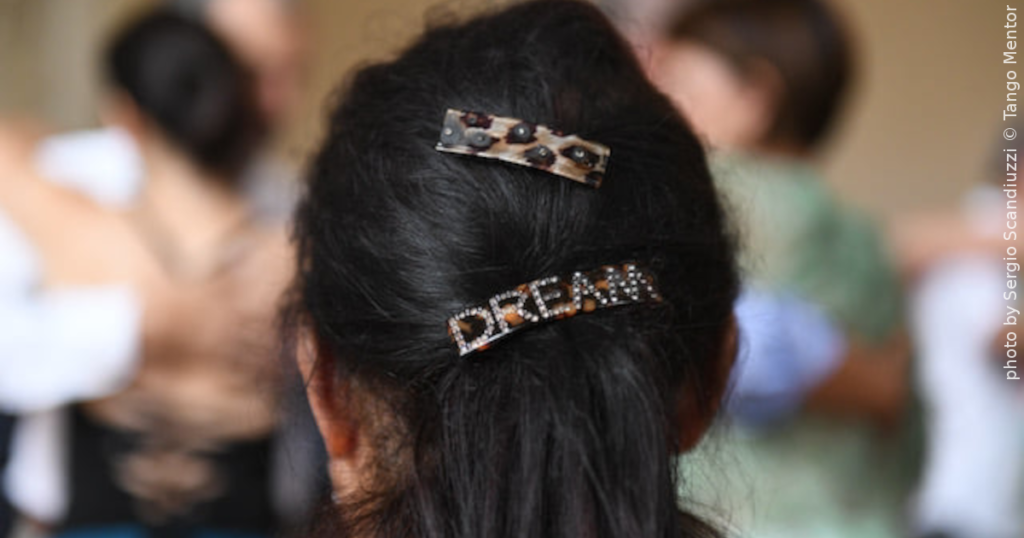
Tango is an intimate and deeply personal experience. An invitation to dance is an invitation to engage in a soulful conversation, to surrender and be vulnerable. That’s why it’s important to invite with respect and consideration. Even a bad cabeceo is better than no cabeceo at all!
But, the cabeceo can be an abstract and unfamiliar concept for those new to the world of tango. Beginners always need information and guidance on how to use it for inviting at a milonga. Unfortunately, I frequently encounter dancers who were never taught about it or were provided with minimal information.
When you don’t deserve a dance
“I need you to teach me how to improve my cabeceo. There’s something wrong – it doesn’t seem to work,” he said.
He had been my student for over a year, and to be honest, his dancing skills were at a moderate level. I had already taught him many aspects of the cabeceo, and he executed it correctly. However, there was another underlying issue: he lacked self-awareness and confidence. He had an awkward and impolite stare that made his partners feel uncomfortable.
Why am I sharing this with you? Because it’s crucial to address the fundamental aspects that go beyond tango itself. These include personal hygiene, respect, and a polite attitude. Once you have ensured these basics, you can focus on learning how to execute the cabeceo.
Remember!
Before you even try doing cabeceo, be sure of the following:
1) that you’re clean and don’t have any bad odor
2) that you show respect and allow them the freedom to reject you
3) that you are polite and pleasant
To be honest, regardless of your dancing level, without these, you don’t deserve to be accepted! If you’re a beginner I’m not telling you this to scare you, but to make you aware of things you have to do before you even start learning about cabeceo.
People often choose to dance with you not solely based on your skills, but rather on how you make them feel.
A step-by-step guide to cabeceo
They say, “When in Rome, do as the Romans do,” which means you need to adapt to the specific customs of the dance community you’re in. However, there are certain points that are widely accepted across most communities, not just those adhering to traditional milonga codes.
Here is a convenient step-by-step checklist for your reference:
- Step #1: Choose the optimal position for success.
- Step #2: Decide who you would like to dance with.
- Step #3: Establish eye contact.
- Step #4: Signal your invitation with a nod of your head.
- Step #5: Approach while maintaining uninterrupted eye contact.
- Step #6: If your invitation is declined, quickly look towards other potential options.
Now that you have the list, let’s delve into the details and explore how you can make your milonga experience a smooth ride.
Step #1: Get into position
Many milongas and events have fixed seating, which means you can choose your chair, and that becomes “your spot,” making it easier for others to find you if they want to dance with you. However, this can be challenging in big or crowded venues. As a result, organizers often suggest fixed seats for ladies while gentlemen walk around to invite.

It’s difficult to determine in advance the best spots that will ensure your success, but I can provide some guidelines for you to consider when choosing your spot.
A spot can be considered a good starting position if it meets one or more of the following criteria:
- You’re within the vision field of your potential partner, ensuring they can clearly see you.
- The spot is well-lit, allowing your face and eyes to be visible.
- You’re in the first row, next to the dance floor, without anyone blocking your view.
- The area is not overly crowded.
However, keep in mind that sometimes you may have to prioritize one criterion over another. For example, well-lit and visible places tend to be more crowded, so you may need to trade visibility for potential obstructions.
On the other hand, there are some spots that can be considered bad for inviting partners. These spots can be described by the following criteria:
- There is a light source right behind you, making it difficult for others to see your face.
- Dancers behind you are making invitations too, which can lead to misunderstandings about whether the invitation was intended for you or the person behind you.
- The spot you choose is used by couples entering the dance floor and they quickly start obstructing your view.
Later, I will explain how to overcome some of these challenges. For now, take note of these negative aspects to be mindful of them when choosing your spot.
Step #2: Decide whom you want to dance with
If you have prior experience with the dancers in the venue, you likely have an idea of the kind of music you prefer and the specific partners you enjoy dancing with. Some partners may excel in slow emotional tangos, while others shine in fast-paced rhythms. You might have a preference for dancing vals with one partner and milonga with another. Before the cortina comes to an end, take a moment to scan the room and locate the dancers you are interested in.
Have in mind the structure of the tandas being played in traditional milonga setup:
tango – tango – vals – tango – tango – milonga – tango – tango – vals – (…)
As the cortina ends and the first song of the tanda begins, quickly determine the music being played and make a decision about whom you want to dance with.
It’s important to remember that dance invitations are not always guaranteed, as your preferred partner may choose to dance with someone else or may not wish to dance at all. It’s smart to have backup options in mind, allowing you to adapt and make the most of the dancing opportunities available to you.
Step #3: Find their eyes
The dance begins with eye contact.
When inviting your desired partner, do so in a non-verbal manner from a distance, allowing them the freedom to refuse if they wish. Convey your interest subtly through a discrete gaze.
It is crucial to maintain a confident yet gentle eye contact while waiting for the other person’s reaction. Keep your chin up, so they can see your face and your intention.
Remember!
In my teaching experience, I’ve noticed that beginners, especially ladies, may feel uncomfortable when it comes to gazing into people’s eyes. My advice is to be mindful that in a milonga setup, maintaining eye contact simply indicates your interest in dancing, nothing more. It’s a way to express your desire to connect on the dance floor. I encourage you to challenge yourself to overcome this initial discomfort and work on developing self-confidence.
Some say that the gentlemen are the ones who extend invitations, but I strongly disagree with this notion. Regardless of whether you are a lady or a gentleman, the mirada, or eye contact, allows both participants to be equally active in the invitation game.
Step #4: Nod with your head
Once eye contact is established, it’s time to confirm if your invitation has been accepted. There are various gestures you can use for this purpose, but the most common involve the head:
- Nodding with the head
- Smiling
- Lifting your eyebrows
- Pointing with your eyes towards the floor
If the target partner answers in the similar manner that means that your invitation is being accepted.
It’s important to note that all of these gestures are focused on the head and don’t involve body movements. You should also avoid any abrupt or exaggerated motions. Whichever gesture you choose, it should be a gentle movement that clearly conveys your intent.
Step #5: Maintain unbroken eye contact
Once you’re certain that your invitation has been accepted, gentlemen, you can begin moving towards your partner while being mindful of the flow of the ronda. If you still have doubts, you can repeat some of the gestures mentioned above.
It is customary for the man to approach the woman’s table, and she stands up only when he is directly in front of her. Having a clear understanding of who is taking which role is crucial to avoid any confusion. Just imagine the potential mix-up if both individuals were to approach each other’s seats simultaneously!
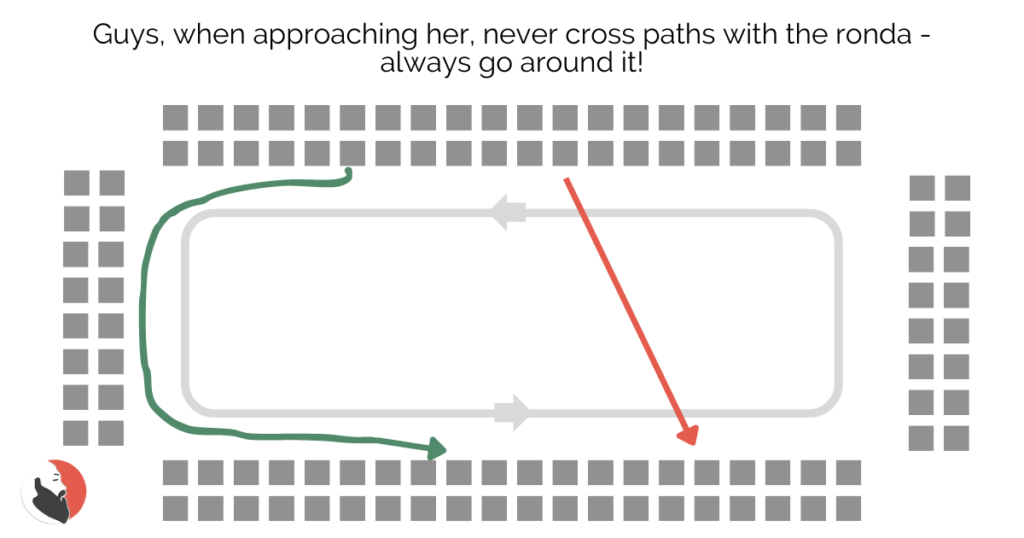
Ladies, if your invitation is accepted, it’s important to stay in your position and patiently wait for your partner to approach you. Avoid the temptation to stand up or initiate any movement on your own. Simply remain where you are until he is directly in front of you. This is especially crucial if you’re uncertain whether the invitation was intended for you.
To avoid any misunderstandings, particularly in crowded milongas when you’re unsure if the cabeceo was intended for you, it’s crucial to maintain unbroken eye contact throughout the process. This ensures clear communication and eliminates any confusion.
Step #6: If they refuse your invitation…
It’s crucial to acknowledge and accept that the person you’re inviting has the freedom to either accept or decline the invitation. Their response, whether it’s a nod or a smile to accept, or looking away to decline, should be respected and honored.
If your invitation is declined, it’s important to gracefully accept their response without taking it personally.
By demonstrating respect for their decision, you contribute to maintaining a positive dance environment for everyone involved. Remember, it’s still essential to maintain friendly interactions with those who may not see you as a potential dancing partner.
In the event that your invitation is declined, quickly redirect your attention towards your backup options mentioned in the second step.
Remember that every dancer encounters refusals at some point, and it’s important not to let it discourage you. Instead, view it as an opportunity for personal growth and self-improvement.
Hey, sorry to interrupt…
Do you like reading my articles? If you do please consider a small contribution to the existence of this blog.
I don’t sell a book or run ads: I share these articles for free. Unfortunately I also have to pay my bills, so if you see value in my work please consider a small donation/gratuity (the same way you tip your favorite bartender).
From my heart to yours!
Ivica
Securely processed via PayPal
How can you make it work for you?
The cabeceo is simple and natural. Beginners may initially have some resistance, but once they become comfortable with it and realize its many advantages it becomes their habit.
One valuable piece of advice for beginners is to attend their first milonga accompanied by someone more experienced who can guide them through the process.
To assist you further, I’ve captured a short video from the event I was DJing at last week in Vilnius, Lithuania. I’ve added captions to provide a clear picture of what’s happening.
The terminology used in this article
As this article aims to assist beginners, here is a brief list of terminology and their meanings:
- Milonga – A venue or event where people gather to dance tango (not to be confused with the type of tango music)
- Cabeceo – A subtle nod of the head to indicate acceptance of a dance invitation
- Mirada – A respectful gaze or glance used to invite someone to dance
- Códigos – The unwritten rules and etiquette of traditional milongas
- Ronda – The circular path on the dance floor where couples navigate and move together
- Cortina – a short piece of non-tango music that separates tandas.
- Tanda – a group of 3 or 4 songs of tango, milonga or vals, meant to be danced with one partner.
These terms will help you better understand the discussions and concepts covered throughout this article.
Questions & Answers
I’m trying to gather up my courage here… The eye contact thing is amazingly difficult… it makes me wonder how we got so messed up?
- Tango exposes us, starting with ourselves. It also provides us with a great platform to address our weaknesses and overcome them. While some cultures may view prolonged eye contact as impolite, it’s important to recognize that the tango environment operates under different rules. This is an excellent opportunity to step out of your comfort zone and confront your vulnerabilities.
My eyesight isn’t great. What can I do if I can’t see well?
- Wearing glasses is a common solution. Many people wear their glasses until they need to step onto the dance floor. Some organizers make it convenient by providing a table near the dance floor where you can safely place your glasses, fans, or other personal items.
It’s too dimly lit to initiate a cabeceo. How can I invite someone if I can’t see their face?
- Unfortunately, not all environments are great for the cabeceo. Some organizers may not prioritize it, leaving you with limited options. Observe what others do in such situations and try to find a compromise. It’s worth noting that many dancers choose to avoid events where the cabeceo is challenging.
In my community, no one is familiar with the cabeceo. How can I extend an invitation?
- In many cases, the specific use of cabeceo may not be crucial. The act of making eye contact and nodding is generally understood as an invitation for a dance, even if they know nothing about it.
But I really want to dance with that person. Can I persist?
- Always respect the freedom of your potential partners to accept or decline your invitation, and avoid taking it personally. If you genuinely desire to dance with someone and are confident that they would enjoy dancing with you, you can approach them near the bar area (most milongas have a designated space for resting and refreshments) and express your desire to share a tanda with them. While not the conventional approach, it is not unheard of, and personally, I have had positive experiences with ladies who approached me in this manner.
Do you have a question that is not answered here? Please leave a comment bellow and I will add it to the article as soon as I can. Thank you!
Further reading
- Use of the Cabeceo and Gender Segregated Seating in Milongas in Buenos Aires and Elsewhere in the World (by Tango Voice)
- El Cabeceo (by Tango Cherie)
- The “Cabeceo” (by Tango and Chaos in Buenos Aires)
How ladies choose partners
Knowing the answer to the question “How ladies choose their partners?” can be game changing…
Why do we need cabeceo/mirada?
Tango starts in the eyes: with cabeceo/mirada. The magic of the dance starts even before…
10 ways to say “No”!
There is a huge number of milongueras who feel uncomfortable in the game of invitations….
How men choose partners
The answer to the question “How men choose partners?” goes far beyond the idea that…
Do you like the article? I wrote it because I strongly believe it can help us build a better tango world where people can have smoother and more enjoyable experiences. If you agree with me, please share it with your tango friends so that it can benefit them too.

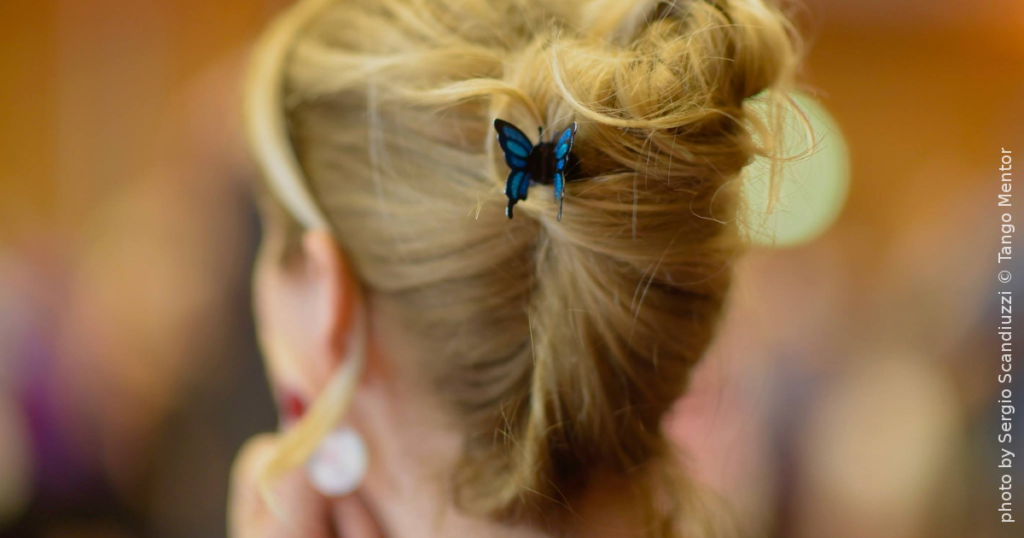
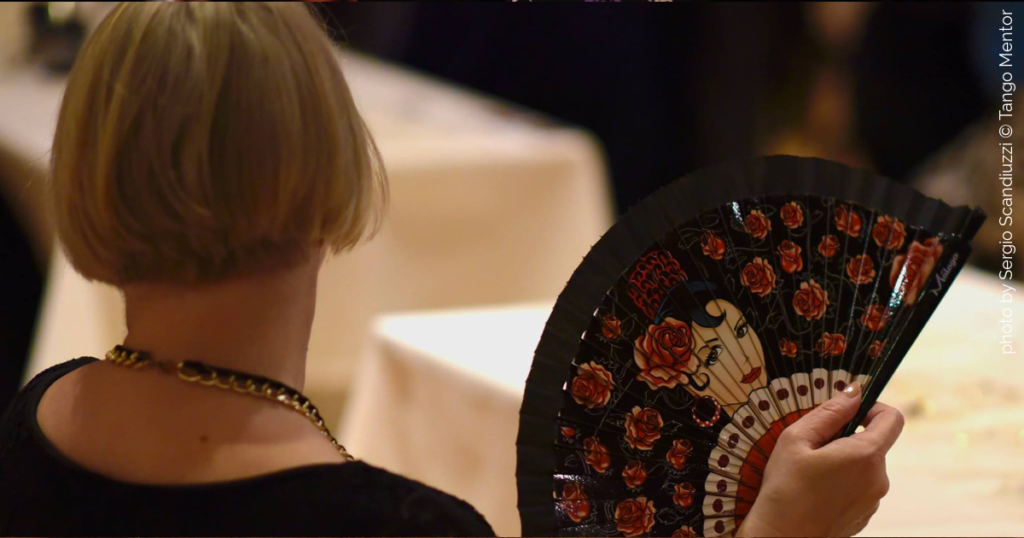
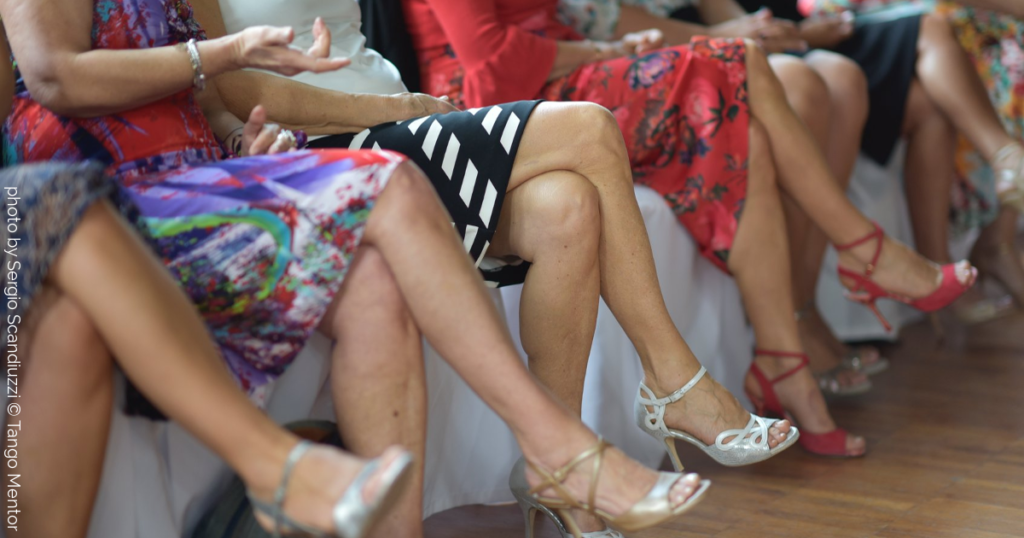

Leave a Reply